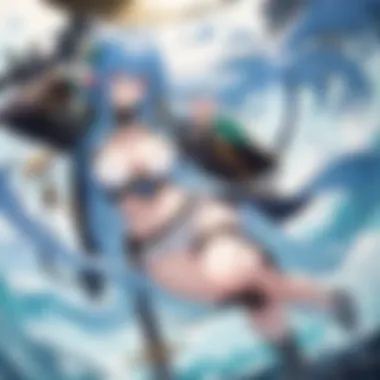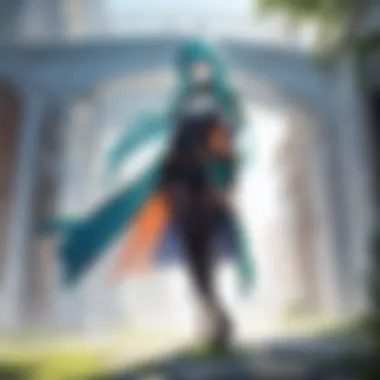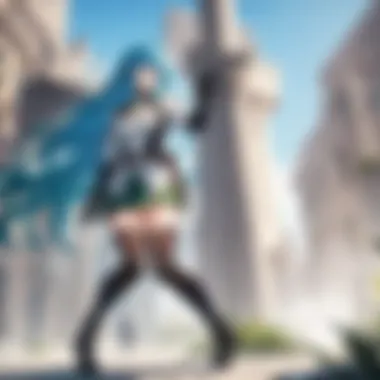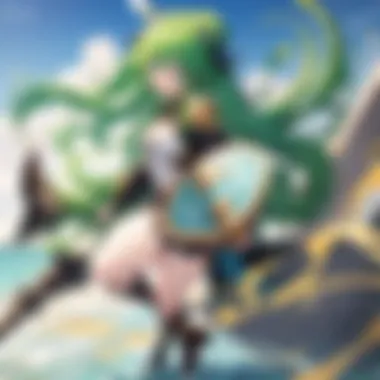Exploring Rising of the Shield Hero: Themes and Impact


Intro
The anime Rising of the Shield Hero has garnered a significant following since its debut. It is essential to understand its appeal and why it resonates with many. This article seeks to explore diverse aspects of the series. By delving into its characters, themes, and cultural impact, we aim to provide both context and analysis for enthusiasts.
Featured Series or Manga
Overview of the Series
Rising of the Shield Hero, based on the light novel by Aneko Yusagi, offers a unique narrative. The story begins with Naofumi Iwatani, who is summoned to a parallel world as the Shield Hero. This role is distinct, as unlike typical heroes, he carries the burden of defensive capabilities. The world he faces is filled with challenges, and the initial reception from others is hostile. This sets a foundation for exploration in heroism and adversity, core themes that develop throughout the narrative.
Key Characters and Development
The series is populated with a range of characters who contribute significantly to Naofumi's journey. Key figures include:
- Raphtalia: A demi-human girl who becomes Naofumi's first companion. Her growth reflects resilience and loyalty.
- Filo: A unique Filolial that adds humor and lightness to the story, while showcasing impressive combat skills.
- Malty Melromarc: The antagonist who initially betrays Naofumi, triggering his journey into darkness and struggle.
The character development in this series is substantial. As the plot unfolds, Naofumi transforms from a distrustful hero into a figure of justice fighting against the odds.
Character Analysis
Major Characters
Each character in the series serves a purpose that ties into the overarching plot. Naofumi stands out, grappling with betrayal and the quest for redemption. Raphtalia's journey from a scared child to a devoted warrior enriches the narrative. Understanding these characters enables the viewer to appreciate their complexities.
Character Arcs and Growth
Character arcs play a crucial role. Naofumi's mistrust and gradual acceptance of companionship illustrate a profound transformation. Raphtalia's development from victim to warrior mirrors Naofumi's journey. Both characters exhibit growth that resonates with audiences, indicating resilience amid adversity.
Thematic Exploration
Main Themes and Messages
The series addresses powerful themes such as heroism, trust, and betrayal. Naofumi's initial hardship challenges conventional notions of what it means to be a hero. The importance of support and companionship also comes to the forefront, demonstrating that strength often lies in unity.
Cultural Context and Influences
Rising of the Shield Hero draws on various cultural references, impacting its reception by global audiences. The themes reflect contemporary societal issues, particularly regarding trust, responsibility, and the notion of heroism. The portrayal of Naofumi as an antihero invites viewers to question their understanding of right and wrong.
The significance of Rising of the Shield Hero manifests in its ability to engage audiences both in narrative and broader cultural conversations.
In summary, the relevance of Rising of the Shield Hero within anime culture and its rich narrative provides ample material for discussion. The examination of character dynamics and thematic depth showcases its importance in modern storytelling.
Foreword to Rising of the Shield Hero
The narrative journey of Rising of the Shield Hero holds a significant place in the anime universe. Understanding this series is essential, as it encapsulates the demand and complexity within modern storytelling in anime. The central character, Naofumi Iwatani, offers a compelling study of growth and resilience. His experiences resonate with themes relevant to contemporary viewers. This introduction sets the stage for a broader exploration of the story's intricacies, themes, and cultural relevance.
Overview of the Series
Rising of the Shield Hero is an isekai anime that premiered in 2019. It is adapted from a light novel series authored by Aneko Yusagi. The story follows Naofumi, an ordinary man who is transported to a fantastical world as one of four cardinal heroes. Each hero is assigned a different weapon, and Naofumi wields the shield, limiting his offensive capabilities. Contrary to his expectations, he faces immediate betrayal, leading to a transformation that forms the narrative's foundation.
The series explores Naofumi's evolution from a victim of the system to a character who embodies determination and strength against adversity. This journey reflects a deeper social commentary on trust and betrayal, making the narrative more profound than typical hero tales.
In addition, the world-building in Rising of the Shield Hero adds layers to the story. The different cultures and political systems within the realm contribute to the tension and complexity in Naofumi's journey. As he gathers allies and confronts various challenges, the viewer learns more about the world, creating an expansive experience beyond Naofumi's immediate struggles.
Core Themes and Concepts


Rising of the Shield Hero is rich in themes that provoke thought and introspection. First, the theme of betrayal is central to the story. Naofumi's initial trust is shattered, setting the tone for his character development. This theme is not just a plot device; it represents broader issues of trust in relationships and society. The ripple effects of betrayal lead to profound character growth.
Another significant theme is justice and morality. The series challenges the notions of right and wrong through its characters' actions. Naofumi’s journey is a testament to the gray areas in morality. His methods may not always align with traditional views of heroism, which raises questions about what constitutes true justice.
Additionally, the concept of resilience amid adversity emerges strongly throughout the series. As Naofumi encounters challenges, he learns not just to survive but to thrive. This resilience is mirrored in other characters, particularly Raphtalia, who becomes a beacon of hope and support.
In summary, the themes in Rising of the Shield Hero are not just narrative elements; they are reflections of complex human experiences. This layered storytelling enhances the connection between the series and its audience, making it relevant in today’s cultural conversations.
Character Analysis
In the realm of Rising of the Shield Hero, character analysis is essential. This article emphasizes how individual characters contribute to the narrative. Understanding characters helps viewers grasp themes and emotional arcs. Focusing on Naofumi, Raphtalia, and other significant characters shows their roles in the story. Their relationships drive the plot and symbolize broader themes. Therefore, deep analysis enhances appreciation of both the series and its cultural context.
Naofumi Iwatani: The Reluctant Hero
Backstory and Development
Naofumi's backstory and development are crucial. He begins as an ordinary otaku, thrust into a fantasy world with little preparation. This transformation from a passive character to an active one is compelling. Naofumi's experiences shape his worldview, impacting his choices. His struggles with betrayal and responsibility render him a relatable figure for many viewers. This character arc exemplifies personal growth amid adversity, which is vital for engaging storytelling. It brings a unique relatability that resonates throughout the series.
Motivations and Growth
Motivations and growth illustrate Naofumi's journey. Initially, his goal is survival, but this evolves into a desire for justice. This change shows how cruelty can shape a person's motivations. His growth represents the struggle to recover one's humanity after facing deep betrayal. This development is engaging because it reflects real human experiences of hardship and recovery. Naofumi's transformation is central to understanding heroism within the narrative.
Raphtalia: The Symbol of Hope
Character Origin and Evolution
Raphtalia’s origin as a slave character introduces themes of redemption. Her evolution from a frightened child to a brave warrior is remarkable. This transformation emphasizes hope and personal agency, making it relatable. The key feature is her strong bond with Naofumi, which enhances both characters' narratives. This relationship stands as a cornerstone of the series. Portraying her evolution provides a depth that draws viewers' empathy and reflects broader societal themes.
Catalyst for Naofumi
Raphtalia serves as a catalyst for Naofumi's growth. Her unwavering loyalty and support push him toward healing and determination. This aspect creates a dynamic interplay that drives the plot. Her significance transcends being merely a companion; she shapes Naofumi’s character arc. This relationship highlights the importance of support in overcoming obstacles. Thus, her role reinforces central themes of trust and partnership in adversity.
Supporting Characters and Their Roles
Bitch and Her Narrative Significance
Bitch, a notable antagonist, serves a key narrative purpose. She embodies betrayal and prejudice, challenging Naofumi's beliefs. Her actions exemplify the cruelty that can exist in society. This character's significance lies in her capacity to drive conflict and tension in the story. By opposing Naofumi, she forces him to confront his past and grow. The complexity she brings adds depth to the overall message of the series about morality and justice.
The Role of Other Companions
The role of other companions, such as Filo and Melty, enriches the narrative. Each character introduces distinct perspectives and abilities, contributing to the team's dynamic. They represent different aspects of heroism and friendship, promoting the idea of unity in diversity. This diversity among characters allows viewers to engage with various themes. Companions provide not only support for Naofumi but also personal growth for themselves, making this ensemble crucial to the overall depth of the story.
Narrative Structure
Narrative structure plays a vital role in shaping the story within Rising of the Shield Hero. It affects how audiences engage with the plot and characters, allowing viewers to connect with the hero's journey on a deeper level. The way events are organized affects emotional investment and understanding of the themes. Each plot arc and conflict resolution forms a significant part of this structure, guiding the audience through the various trials faced by Naofumi and his companions. By analyzing these components, we can appreciate the craftsmanship behind the narrative and its connection to cultural themes.
Plot Arcs and Their Impact
The series features multiple plot arcs that contribute significantly to both character development and thematic depth. Each arc presents new challenges and evolves the narrative further. The progression from Naofumi's unpositioned status to his evolution as a reluctant hero showcases the transformation integral to the series’ core message.
- First Arc: The initial setup introduces Naofumi's struggle against betrayal, outlining his motivations shaped by adversity. It pushes him into isolation yet forms the crux of his growth.
- Subsequent Arcs: Each arc introduces key supporting characters like Raphtalia and new challenges that refine Naofumi’s character. The introduction of new villains and allies provides a contrast that enriches narrative layers.
The impact of these arcs resonates with viewers, highlighting themes such as justice and redemption. The feeling of progression engages the audience deeply as they witness the growth of characters amid escalating stakes.
Conflict and Resolution
Conflict is crucial in Rising of the Shield Hero, driving the narrative forward and forcing characters to adapt. Naofumi’s initial conflict with the kingdom and its citizens sets a foundation of mistrust and cruelty. This conflict escalates into various facets, including personal struggles within his team and external threats posed by antagonists.


- Internal Conflicts: Naofumi battles his own insecurities and mistrust, which complicate his relationships with companions. This inner turmoil is mirrored in the external conflicts he faces.
- External Conflicts: Challenges posed by other heroes or monsters serve to test Naofumi's resolve and ethical boundaries, showcasing his growth in response to adversity.
Resolution often comes through unexpected alliances and the gradual dismantling of the misconceptions surrounding Naofumi's character. The resolution of conflicts reinforces the overarching theme of resilience, illuminating the idea that true heroism often arises from the deepest struggles. As each conflict resolves, it propels the story toward further evolution, ensuring the stakes remain high and engaging.
"The true measure of a hero is not found in their triumphs, but in their willingness to rise from their setbacks."
In summation, narrative structure in Rising of the Shield Hero is not merely a framework—it shapes audience experiences and perceptions of character. Through meticulous crafting of plot arcs and dynamic conflict resolution, the series resonates deeply with its viewers, making it a significant part of contemporary anime cinema.
Visual and Artistic Style
The visual and artistic style of Rising of the Shield Hero plays a crucial role in shaping the viewer's experience. This aspect involves the animation quality, character design, and overall aesthetic choices made by the creators. Each of these elements combines to create a unique atmosphere that resonates with the anime's themes. By examining the visual aspects closely, we can appreciate how they enhance the plot and character development.
Animation Quality
The animation quality of Rising of the Shield Hero stands out in several areas. The fluidity of motion during action scenes adds a dynamic feeling that creates tension and excitement. Key battle sequences are particularly well-executed, showcasing impressive craftsmanship.
In addition, the color palette used is noteworthy. The vibrant colors contrast effectively with darker themes, emphasizing moments of despair and triumph. This contrast helps to convey emotions that the characters experience throughout their journeys. The consistency in the animation style maintains a professional appearance that keeps audiences engaged.
Another important point is the attention to detail. Backgrounds are rich and often filled with intricate designs, helping to build the world that Naofumi inhabits. This immersion is essential for drawing viewers into the story, making them feel part of the adventure. The quality of animation, particularly during pivotal scenes, illustrates the high stakes faced by the characters, enhancing the narrative's impact.
Character Design and Symbolism
Character design in Rising of the Shield Hero reflects deeper meanings and symbolism. Each character's aesthetic is carefully crafted to echo their personalities and roles within the story. For instance, Naofumi Iwatani's design emphasizes his initial vulnerability through muted colors and simple clothing that evolves as he grows into his role as the Shield Hero.
Raphtalia, on the other hand, is designed with a mix of innocence and strength. Her appearance shifts from being a frightened child to a confident warrior, visually representing her character arc. The art direction aligns with the thematic elements of trust, growth, and resilience.
Moreover, the use of facial expressions contributes significantly to character portrayal. Subtle changes in design and expression communicate unspoken emotions and conflicts, allowing viewers to connect with the characters on a deeper level.
As viewers engage with the narrative, the visual craftsmanship deepens their connection to the character dynamics and themes of the series.
Thematic Explorations
The thematic explorations within Rising of the Shield Hero serve as essential components that elevate the series beyond mere entertainment. It allows viewers to engage with deeper questions about society, ethics, and personal growth. Each theme examined in the series provides valuable insights into the motivations of characters and the unfolding narrative. The incorporation of these themes resonates with audiences, encouraging them to reflect on their own values and beliefs.
Justice and Morality
In Rising of the Shield Hero, the concepts of justice and morality are intricately woven into the storyline. Naofumi Iwatani, the protagonist, grapples with issues of fairness from the moment he is summoned to a new world. Betrayed and falsely accused, he confronts the harsh realities of justice not being blind; instead, it often favors the powerful. This examination challenges traditional notions of heroism, forcing viewers to question what true justice means.
Moral dilemmas arise frequently throughout the series. Naofumi's journey reflects the struggle between right and wrong, as he must navigate a world that does not adhere to the same moral compass he once held. His decisions often pivot on a knife-edge, showcasing how circumstances can reshape one's values.
Trust and Betrayal
Trust is a fragile construct in Rising of the Shield Hero. At its core, the narrative explores how betrayal can fundamentally alter relationships. Naofumi’s initial trust in others is shattered by treachery, particularly from those he once considered allies. This theme illustrates how betrayal can resonate deeply, affecting one's ability to trust again.
Raphtalia serves as a crucial character who embodies the rebuilding of trust. Her loyalty becomes a symbol of hope and a stark contrast to the betrayal Naofumi faces. The geographical and emotional journey they share emphasizes the importance of trust in overcoming adversity. By witnessing the interplay of trust and betrayal, audiences gain insight into human relationships and the complexities of forgiveness.
Resilience in Adversity
Resilience is a prominent theme in Rising of the Shield Hero, encapsulated in Naofumi’s relentless determination to rise above his circumstances. The series presents his struggles as a stark reminder that resilience often emerges from hardship. Each setback he faces serves not only as a test of his character but also as a metric of his growth.
Naofumi's response to adversity—transforming initial weakness into strength—mirrors the broader narrative arc. The series portrays challenges not as insurmountable barriers but as catalysts for development. This message of resilience resonates with audiences, encouraging them to confront their own challenges with a similar spirit.
"In a world that often feels unjust, rising against adversity defines the essence of true heroism."
In summary, the thematic explorations in Rising of the Shield Hero not only enrich the story but also foster meaningful discourse on justice, trust, and resilience. The way these themes interconnect enhances audience engagement, providing a profound commentary on human experience.
Cultural Impact


The cultural impact of Rising of the Shield Hero is multifaceted, extending beyond mere entertainment to invoke discussions about core themes in society. The anime has shaped many viewers' perspective on heroism, betrayal, and personal growth. By engaging with these complex themes, it resonates with an audience that seeks depth in storytelling. This series has also carved out a space within the anime community where discussions flourish, driven by its unique narrative and thoughtful character development.
Fan Reception and Critique
Fan reception of Rising of the Shield Hero has been a rollercoaster. From its initial release, it sparked a range of responses. Some viewers were drawn in by Naofumi's character arc, relating to his struggles and transformation. Others, however, critiqued elements of plot pacing and character design.
The divided opinions often dominate online forums. Websites like Reddit have host many threads analyzing episodes, dissecting character motivations. Many fans appreciate the depth of Naofumi's character, often viewing him as a symbol of resilience in the face of adversity. For instance, a prevalent discussion point is how his evolution reflects real-life challenges, a contrast to more traditional portrayals of heroes.
"The way Naofumi navigates betrayal hits close to home, making it relatable and profound." – User comment, Reddit
Overall, while critiques exist, the series has amassed a loyal following. This mix of adoration and criticism helps to foster a dynamic dialogue, showcasing the importance of fan engagement in the anime's cultural significance.
Merchandising and Community Engagement
Merchandising strategies surrounding Rising of the Shield Hero have greatly enhanced its visibility in the mainstream market. From figures to apparel, products are available for fans to express their connection to the series. This accessibility plays a key role in maintaining interest among existing fans and attracting new viewers.
Social media has played a central role as well. On platforms like Facebook, fans share art, theories, and merchandise. This community-driven content not only strengthens the bond among fans but also expands the series' reach. Special events, like online watch parties and merchandise launches, create buzz and encourage active participation from the audience.
In summary, while engagement and merchandise offer fans a tangible connection to the series, they also fortify Rising of the Shield Hero's cultural footprint. Fans take part in shaping this universe, making the experience personal and interactive. The synthesis of reception, critique, and merchandise significantly contributes to its impact within the anime landscape.
The Digital Landscape
The digital landscape plays a critical role in shaping how audiences consume and interact with content related to Rising of the Shield Hero. With the rise of streaming platforms and online communities, anime has become more accessible than ever before. The shift from traditional broadcasting to digital streaming has created opportunities for fans to engage with their favorite series at their convenience. This transition is significant, as it not only enhances viewer experience but also fosters a global dialogue around the themes presented in the anime.
Streaming Platforms and Accessibility
Streaming services like Crunchyroll, Funimation, and Netflix provide on-demand access to Rising of the Shield Hero. This immediate availability allows viewers to watch episodes without delay. Furthermore, having a diverse range of languages supports international audiences, making it easier for fan bases to develop worldwide.
Additional benefits include:
- Licensing Flexibility: Different platforms often offer unique versions of the show, sometimes with additional content or commentary.
- User Engagement: Streaming services typically feature user ratings and reviews that can influence viewing choices.
- Subscription Models: Affordable subscription plans allow consumers to access multiple shows, encouraging broader consumption of anime.
Influence of Online Communities
Online communities have become essential in creating a sense of belonging among fans of Rising of the Shield Hero. Platforms like Reddit, Facebook, and various fandom forums facilitate discussions and analysis of episodes. These communities offer a space for fans to share theories, fan art, and critiques, enhancing their connection to the narrative and each other.
The influence of online communities is notable for several reasons:
- Collaborative Analysis: Fans often dissect plot points and character motivations in depth, providing rich insights not always accessible through formal critiques.
- Social Interaction: Fans can form friendships and connections over shared interests, making the viewing experience more engaging.
- Crowdsourced Content: Platforms often serve as launching pads for fan-made projects such as animations or comics that expand the universe of Rising of the Shield Hero.
Online discussions around Rising of the Shield Hero can often lead to a deeper understanding of the story’s themes and character arcs.
By embracing the digital landscape, Rising of the Shield Hero thrives not only as an animated series but as a pivotal part in the vibrant ecosystem of modern anime culture.
The End
The conclusion serves as a critical component within this exploration of Rising of the Shield Hero. It encapsulates the main themes of the article while tying together the various elements discussed in previous sections. This is not merely a recap but a synthesis of insights meant to enlighten the reader about the nuances of the series and its cultural resonance.
Summary of Key Insights
Reflecting on the series, several key insights emerge:
- Character Depth: Naofumi Iwatani's transformation from a naive hero to a complex figure grappling with betrayal highlights the intricacy of character development.
- Thematic Relevance: The themes of justice, trust, and resilience reveal deep societal issues, resonating with viewers on multiple levels.
- Cultural Reach: The impact of online communities shows how Rising of the Shield Hero stimulates conversation and fan engagement, fueling its popularity across platforms.
These insights underline the significance of the series in the larger context of anime, illustrating how it engages with its audience while confronting both timeless and contemporary issues.
Future Directions for the Franchise
As for the future directions of the Rising of the Shield Hero franchise, there are several aspects to consider:
- Potential Sequels: With the successful launch of the first two seasons and the light novels continuing the story, there is ample room for future adaptations. Fans eagerly await how the narrative unfolds further, particularly concerning Naofumi's continuing journey.
- Expanded Media: Possible adaptations into video games or manga could expand its reach and diversify engagement. This can attract a new audience while keeping current fans invested in the franchise's evolution.
- Community Engagement: Leveraging platforms like Reddit and Facebook for fan theories and discussions can drive deeper community involvement. Such interaction can enrich the narrative experience and increase viewer loyalty.
In summary, Rising of the Shield Hero not only serves as entertainment but also as a platform for discussion, reflection, and community formation. Its future looks promising, with opportunities for growth that could further its cultural impact.



